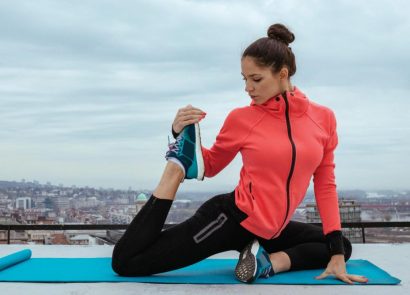Boost your health and get moving with our easy, expert-approved walking plan
With our busy lives, finding the time to add an extra stroll into your day can seem a little overwhelming, but even a trip to go and refill your water bottle can help you boost your daily step count. “In terms of overall benefits and accessibility, you’ll be hard pushed to find a better activity than walking,” says Kristoph Thompson, our resident personal trainer. “Walking helps to increase your fitness, improve health, burn calories, as well as increasing bone density and toning the muscles in your lower body. It’s also much cheaper than a gym membership and easier to fit into your day than other forms of exercise.” It’s all well and good telling yourself that you’re going to move more, but before you start Googling the best walking trainers of 2020, there are a few basics to cover until you’re ready to step out your front door.
Tailor your technique
Put one foot in front of the other. Sounds easy, right? Well, as Kristoph explains, there’s a bit more to it than that.
1. Try and walk with an upright posture. Imagine growing tall from the crown of your head, with your shoulders back and down. This will help you to breathe more efficiently. You shouldn’t feel any tension in your neck or shoulders, as this can contribute to soreness during, and after, activity.
2. Walk with natural, relaxed arm action, allowing your shoulders to rotate forwards and backwards slightly as you move.
3. Pushing off with your glutes will help you walk more efficiently. Place your fingertips against your glutes periodically to check that they are contracting as you move forwards.
Get to grips with your gait
“Our gait is simply described as the manner in which we move place to place,” says William Kenton, leading physiotherapist and spokesperson for Mentholatum. “The gait cycle involves two main phases: the stance phase and the swing phase. The stance phase (from the heel striking to push off) is responsible for 60 percent of our gait cycle while the swing phase (push-off phase to heel strike) is 40 percent of our gait cycle. We all have subtle variations in our gait, however, a pathological gait is defined as an altered gait pattern due to deformities, weakness or other impairments such as hip, knee or ankle conditions or pain.”
Perfect your posture
“Our posture can affect our walking, but the drivers of this vary in each of us,” explains William. “Some individuals tend to walk slightly differently due to anatomical variations, such as leg length discrepancies. The muscles around our hip and pelvis contribute to our posture and muscle tightness, and this can also cause changes in our walking pattern. Individuals with less mobility of their hips or spine might walk a bit more flexed or with a reduced stride length. I always recommend stretching and using products, such as a deep heat muscle massage roll on lotion, to help ease any muscle tightness.”
Walking myths
You must walk 20k steps a day
“Now, this is a great way to keep fit but isn’t appropriate for everyone,” advises William. “Those just starting their exercise journey might struggle to complete this task and feel defeated if they don’t achieve it. It might be better to start with shorter distances that elevate your heart rate. Research from The American Heart Association (AHA) shows breaking up 30 minutes of brisk walking into 10-to-15-minute instalments can lower your risk of high blood pressure, high cholesterol and diabetes – all risk factors for heart disease and stroke.”
Walking isn’t effective for weight loss
“This depends largely on the duration and intensity, of your walking habits,” explains William. “Mixing up your routine by walking at varying speeds, and perhaps with an incline, can burn approximately 20 percent more calories than walking at a set pace.”
Small increases in walking won’t benefit my health
“This isn’t true,” disputes William. “Any increase in your current walking will benefit your health. Walking an additional 2,000 steps per day — even if your current step count is minimal it helps lower your body mass index and boost insulin sensitivity, which allows the body to use blood glucose more effectively.”
Walking is bad for your joints
“Often those with arthritis might be advised to do non-weight-bearing exercises to reduce the load on their joints,” says William, “But in fact, bone and cartilage health are maintained through loading, so walking can be an effective strategy in aiding joint health.”
Your walking planner
“This plan is designed to take you from a starting point of a relatively small amount of activity, all the way through to completing 10k by the end of week four,” says Kristoph. “You’ll start off with a series of shorter walks of varying paces during the week, and then one long walk at the weekend. Walking on a flat, level surface is easiest, however, incorporating hills and a range of terrains (such as forest trails) will increase the challenge and fitness benefits. For added convenience, there’s the option of accumulating the minutes of the mid-week walks throughout the day, but the long Saturday walk is best completed in one go. That said, it can work well to break the walk with a stop at a shop or similar, just make sure that whatever you have to eat or drink is in line with your healthy eating plan!”
Easy walk = This is a comfortable pace that you could maintain for hours if you needed to. Your breath will be relaxed and you can comfortably talk to a friend or someone on the phone while walking. Approximately 4km/h.
Medium walk = You may feel moderately out of breath, but this pace should feel relatively comfortable. You should be able to hold a conversation, but you’ll feel out of breath during longer sentences. Approximately 5.5km/h.
Fast walk = You’ll feel out of breath and find it difficult to hold a conversation walking at this pace. It should feel like an effort to maintain this pace – listening to music with an upbeat tempo can help you to keep it up. Approximately 6.5km/h.
Week 1
Monday: 20 mins fast walk
Tuesday: 45 mins easy walk
Wednesday: Rest
Thursday: 40 mins medium walk
Friday: 30 mins medium walk
Saturday: 5k (45 mins fast walk/55 mins medium walk/75 mins easy walk)
Sunday: Rest
Week 2
Monday: 25 mins fast walk
Tuesday: 30 mins medium walk
Wednesday: Rest
Thursday: 45 mins medium walk
Friday: 45 mins easy walk
Saturday: 6.5k (60 mins fast walk/70 mins medium walk/95 mins easy walk)
Sunday: Rest
Week 3
Monday: 45 mins medium walk
Tuesday: 50 mins easy walk
Wednesday: Rest
Thursday: 25 mins fast walk
Friday: 35 mins medium walk
Saturday: 8k (75 mins fast walk/90 mins medium walk/120 mins easy walk)
Sunday: Rest
Week 4
Monday: 50 mins medium walk
Tuesday: 50 mins easy walk
Wednesday: Rest
Thursday: 30 mins fast walk
Friday: 35 mins medium walk
Saturday: 10k (90 mins fast walk/1hr 50 mins medium walk/2.5 hrs easy walk)
Sunday: Rest



















